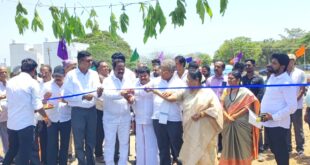The Kiran Nadar Museum of Art (KNMA) is delighted to present at Madras Art Weekend a constellation of artworks from the KNMA collection, that highlight some of the significant artistic underpinnings that followed after India’s Independence and cultural emancipation from colonial rule. The crisscrossing of artistic vocabularies, creative ideas, evolving visual languages and pedagogical approaches, lay out a fertile terrain for addressing multiple engagements with the modern and the post-colonial in India.
An intricate and complex cartography emerged with artists’ migration, travel and movement across regions and institutions. With more than 150 artworks from the KNMA collection, this exhibition will touch upon some nodal points of convergence and diffusion that shaped the contemporary artistic ethos. It will bring into focus cultural connections across India that occurred through art education and pedagogy, starting in the eastern region in Santiniketan and Calcutta in the early 20th century and were carried all the way to the western part in Baroda around mid-20th century, and Delhi in the north by artists including KG Subramanyan and Somnath Hore. Creating parallel learning centres for art, these sites were independent and unique, that broke free from the colonial pedantic ways; with some of their cultural arcs originating a few decades before 1947.
There was the Art School in Santiniketan (1921 later declared a central university in 1951), The Calcutta Group (1943- 50s), Progressive Artists’ Group of Bombay (1947), The Madras Art Movement/ Madras Progressives (1944) followed by the Cholamandal Artists’ village (1966) and Delhi Silpi Chakra (1949) founded by Bhabhesh Sanyal, PNMago, Dhanraj Bhagat and others in the capital, all nurtured diverse practices and camaraderies. This spirit took a dynamic form amongst artists in Baroda and the Indian Radical Painters’ and Sculptors’ Association from Kerala. They unfolded many conflicting and inspirational paths, drawing from the immediacy of the ‘local’ and addressing the question of relevance.
J. Swaminathan, Jeram Patel, Gulammohammed Sheikh, Reddappa Naidu and Himmat Shah, among others initiated the short-lived Group 1890 in 1963, with artist and critic
Swaminathan spearheading it, providing a completely new direction to Indian modernism. While KP Krishna Kumar, KM Madhusudhanan, CK Rajan, Alex Mathew, NNRimzon,
Surendran Nair and Anita Dube formulated the Indian Radical Painters’ and Sculptors’ Association (1987-89), with a foundation in Marxist ideologies, critiquing revivalism and
nostalgic tendencies.
On the other hand in the 1960s the Madras Art Movement focused on the local and traditional aesthetics to establish a regional form of Modernism that was culturally unique to South India. Under the mentorship of Devi Prasad Roy Chowdhury, who was principal at the Madras School of Arts and Crafts (then) from 1930, and eventually under KCS
Paniker, principal (1957–66) the early sixties, saw a group of artists mentored by Paniker who were critically evaluating models of Western modernism and pursuing
alternatives more immediate and relevant. C. Douglas and K. Ramanujam became fitting successors of Paniker, whose strong imagery and emotive powers marked a distinct
trajectory.
Starkly distinct in the north, Madan Mahatta was documenting the modern face of India as ‘a nation in the making’ through its architectural projects (1950s– 80s) in his spellbinding black and white photographs.
The narrative around Indian modernism was male-dominated for the longest time, while
alternative voices of women artists such as Arpita Singh, Madhvi Parekh and Meera Mukherjee and others were foregrounding new awareness towards art making, layering it with their subjectivity and personal experiences.
Younger generations of artists like Manjunath Kamath, Pooja Iranna, K. Benitha Perciyal and Dilip Chobisia resonate with equal zest, the possibilities of unconventional mediums and new material, which one encountered in Himmat Shah, Jeram Patel, Somnath Hore, Krishna Reddy and KG Subramanyan. Manjunath experiments with mixed media on canvas, Pooja makes sculptures with staple pins and Dilip with epoxy resin, cement,
stone dust & earthen colour. Benitha Perciyal explores unusual material such as bark powder, cinnamon, clove, lemongrass, cedar wood and essential oils .
EXHIBITION DETAILS:
The MOVING ARC
Artistic Encounters in India (1940s onwards)
Date: 29 November – 22 December 2023
Venue: Lalit Kala Akademi, Chennai
For Madras Art Weekend
 Expressnews
Expressnews








